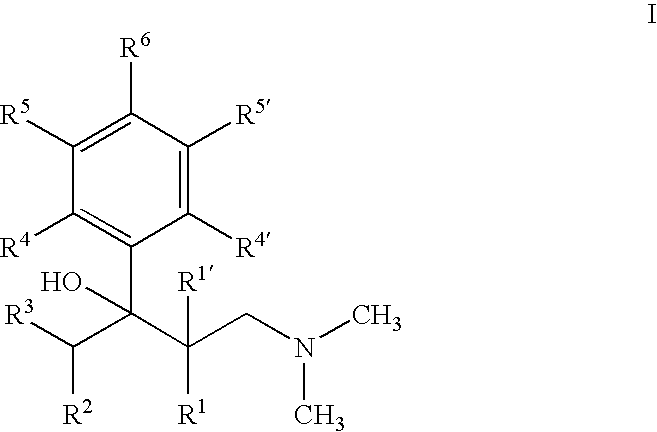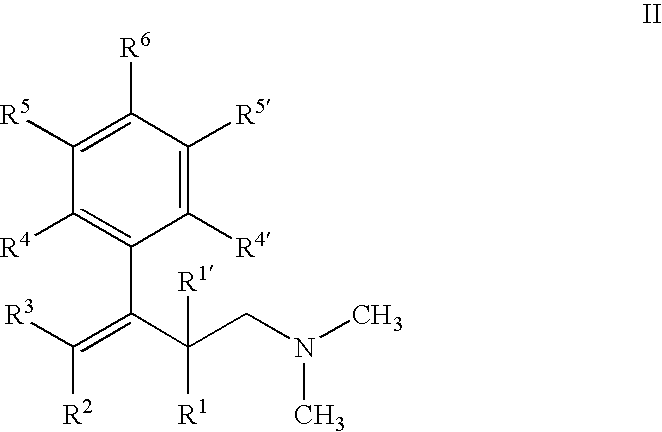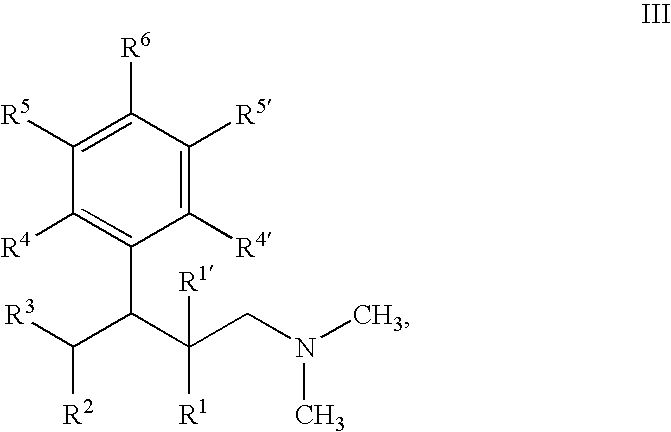Process for the dehydration of substituted 4-dimethylamino-2-aryl-butan-2-ol compounds and process for the preparation of substituted dimethyl-(3-aryl-butyl)- amine compounds by heterogeneous catalysis
a technology of arylbutan and dimethylamino-2-ol, which is applied in the field of process for the dehydration of substituted 4dimethylamino2arylbutan2ol compounds and to the process for the preparation of substituted dimethyl(3arylbutyl)amine compounds by heterogeneous catalysis, can solve the problems of equipment corrosion, acid used for the dehydration must subsequently be separated, and the production cost of the process is also high
- Summary
- Abstract
- Description
- Claims
- Application Information
AI Technical Summary
Problems solved by technology
Method used
Image
Examples
example 1
Preparation of the Bifunctional Catalyst
1a)
[0076] In a round-bottomed flask, 2 g of a sulfonic-acid-group-carrying ion-exchange resin based on a styrene / divinylbenzene copolymer having a divinylbenzene content of 20 wt. %, based on the total weight of the resin, a mean pore diameter of 25 nm and a minimum concentration of active groups of 4.70 equivalents per kg of resin (Amberlyst® 15, Fluka, Switzerland) were suspended in 20 ml of water. 0.3 ml of a palladium tetramine dinitrate hydrate solution having a palladium content of 69.5 mg / ml was then added, and stirring was carried out for 24 hours at a temperature of 80° C. To prepare the palladium(II) tetramine nitrate hydrate complex solution, 10 g of palladium(II) nitrate dihydrate (Fluka) were added to 400 g of ammonia solution (25 wt. % in water) and the mixture so obtained was stirred for 3 days at 50° C. The undesired solid was then separated off by filtration, and the palladium content was determined by ICP-AES, as described...
example 2
Synthesis of (Z;E)-(S)-[3-(3-methoxy-phenyl)-2-methyl-pent-3-enyl]-dimethyl-amine; hydrochloride (2) from (−)-(2S,3S)-1-dimethylamino-3-(3-methoxy-phenyl)-2-methyl-pentan-3-ol; hydrochloride (1)
[0078]
1.0 g (3.4 mmol.) of (−)-(2S,3S)-1-dimethylamino-3-(3-methoxy-phenyl)-2-methyl-pentan-3-ol; hydrochloride (1) and 0.5 g of a sulfonic-acid-group-carrying ion-exchange resin based on a styrene / divinylbenzene copolymer having a divinylbenzene content of 20 wt. %, based on the total weight of the resin, a mean pore diameter of 25 nm and a minimum concentration of active groups of 4.70 equivalents per kg of resin (Amberlyst® 15, Fluka, Switzerland) were placed in a 75 ml stainless steel autoclave. After addition of 15 ml of freshly distilled ethanol, the reaction mixture was stirred for 4 hours at 150° C. in the closed system (at an overall pressure of up to 8 bar). After cooling to room temperature (about 20-25° C.), the catalyst was filtered off. A sample of the filtrate so obtained was...
example 3
Synthesis of (−)-(2R,3R)-[3-(3-methoxy-phenyl)-2-methyl-pentyl]-dimethyl-amine; hydrochloride (3a) and (−)-(2R,3S)-[3-(3-methoxy-phenyl)-2-methyl-pentyl]-dimethyl-amine; hydrochloride (3b) from (Z)-(S)-[3-(3-methoxy-phenyl)-2-methyl-pent-3-enyl]-dimethyl-amine; hydrochloride (2)
[0080]
1.0 g (3.7 mmol.) of (Z)-(S)-[3-(3-methoxy-phenyl)-2-methyl-pent-3-enyl]-dimethyl-amine; hydrochloride (2) and 0.5 g of the catalyst obtained according to Example 1a were placed in a 75 ml stainless steel autoclave. The autoclave was evacuated under a medium-high vacuum and then gassed with argon. Under an argon atmosphere, 15 ml of freshly distilled ethanol were added. A hydrogen pressure of 4 bar was then applied at room temperature, and the reaction mixture was stirred for 4 hours at 150° C. (overall pressure at 150° C. up to 12 bar). After cooling to room temperature, the excess hydrogen was let off and the catalyst was filtered off. A sample of the filtrate was taken and analyzed by gas chromatog...
PUM
| Property | Measurement | Unit |
|---|---|---|
| Temperature | aaaaa | aaaaa |
| Temperature | aaaaa | aaaaa |
| Temperature | aaaaa | aaaaa |
Abstract
Description
Claims
Application Information
 Login to View More
Login to View More - R&D
- Intellectual Property
- Life Sciences
- Materials
- Tech Scout
- Unparalleled Data Quality
- Higher Quality Content
- 60% Fewer Hallucinations
Browse by: Latest US Patents, China's latest patents, Technical Efficacy Thesaurus, Application Domain, Technology Topic, Popular Technical Reports.
© 2025 PatSnap. All rights reserved.Legal|Privacy policy|Modern Slavery Act Transparency Statement|Sitemap|About US| Contact US: help@patsnap.com



